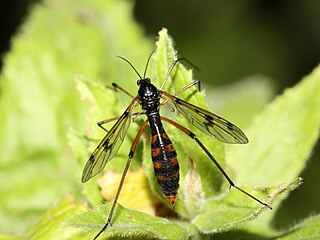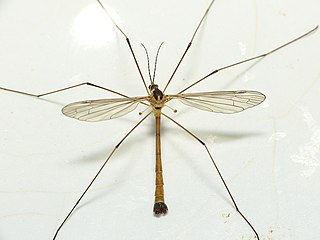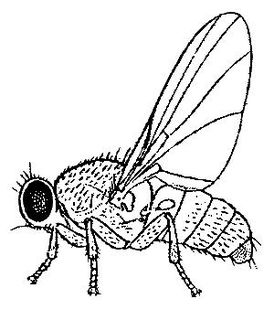
Flies are insects of the order Diptera, the name being derived from the Greek δι- di- "two", and πτερόν pteron "wing". Insects of this order use only a single pair of wings to fly, the hindwings having evolved into advanced mechanosensory organs known as halteres, which act as high-speed sensors of rotational movement and allow dipterans to perform advanced aerobatics. Diptera is a large order containing an estimated 1,000,000 species including horse-flies, crane flies, hoverflies and others, although only about 125,000 species have been described.

The Tachinidae are a large and variable family of true flies within the insect order Diptera, with more than 8,200 known species and many more to be discovered. Over 1300 species have been described in North America alone. Insects in this family commonly are called tachinid flies or simply tachinids. As far as is known, they all are protelean parasitoids, or occasionally parasites, of arthropods, usually other insects. The family is known from many habitats in all zoogeographical regions and is especially diverse in South America.

The Calliphoridae are a family of insects in the order Diptera, with almost 1,900 known species. The maggot larvae, often used as fishing bait, are known as gentles. The family is known to be polyphyletic, but much remains disputed regarding proper treatment of the constituent taxa, some of which are occasionally accorded family status.

The Nematocera are a suborder of elongated flies with thin, segmented antennae and mostly aquatic larvae. Major families in the suborder include the mosquitoes, crane flies, gnats, black flies, and a group of families described as midges.

Tanyderidae, sometimes called primitive crane flies, are long, thin, delicate flies with spotted wings, superficially similar in appearance to some Tipulidae, Trichoceridae, and Ptychopteridae. Most species are restricted in distribution. They are found in many parts of the world, including North America, South America, Africa, Australia, New Zealand, and various islands in the Pacific Ocean. Adults are usually found hanging from vegetation near streams. Larvae are found either in sandy stream margins or in wet, rotten wood. Fossil species are known.

Trichoceridae, or winter crane flies, of the order Diptera are long, thin, delicate insects superficially similar in appearance to the Tipulidae, Tanyderidae, and Ptychopteridae. The presence of ocelli distinguishes the Trichoceridae from these other families. There are approximately 160 known species. The adults can be found flying in the fall and the spring and some are active even in the winter, hence their common name. They form dancing, loose swarms of mostly males. Adults can also be found resting inside caves and hollow logs. Larvae occur in moist habitats where they feed on decaying vegetable matter. They are of no economic importance.

The Ptychopteridae, phantom crane flies, are a small family of nematocerous Diptera. Superficially similar in appearance to other "tipuloid" families, they lack the ocelli of the Trichoceridae, the five-branched radial vein of the Tanyderidae, and the two anal veins that reach the wing margins of the Tipulidae. They are usually allied with the Tanyderidae based on similarities of the mesonotal suture, this group being called the Ptychopteromorpha.

The Empidoidea are a large monophyletic superfamily of true flies, the sister taxon to the Muscomorpha (Cyclorrhapha). These two groups are sometimes united in the unranked taxon Eremoneura. There are some 10,000 known species within Empidoidea, which are represented on all continents except Antarctica. They are known to have existed since the Jurassic period.

Dolichopodidae, the long-legged flies, are a large, cosmopolitan family of true flies with more than 7,000 described species in about 230 genera. The genus Dolichopus is the most speciose, with some 600 species.

Empididae is a family of flies with over 3,000 described species occurring worldwide in all the biogeographic realms but the majority are found in the Holarctic. They are mainly predatory flies like most of their relatives in the Empidoidea, and exhibit a wide range of forms but are generally small to medium-sized, non-metallic and rather bristly.

Clusiidae or "druid flies" is a family of small, thin, yellow to black acalyptrate flies with a characteristic antenna and with the wing usually partially infuscated. They have a cylindrical body. The head is round, the vertical plate reaches the anterior margin of the frons and the vibrissae on the head are large. The costa is interrupted near subcosta and the latter developed throughout length. Larvae are found in the bark of trees, the flies on trunks. The larvae are notable for their ability to jump. Males of many species in the subfamily Clusiodinae have been observed while engaged in lekking behaviour. There are hundreds of species in 14 genera found in all the Ecoregions, although most species occur in tropical regions. The type genus is Clusia Haliday, 1838.

Atelestidae is a family of flies in the superfamily Empidoidea. The four genera were placed in a separate family in 1983; they were formerly either in Platypezidae or considered incertae sedis. While they are doubtless the most basal of the living Empidoidea, the monophyly of the family is not fully proven. The genus Nemedina seems to represent a most ancient lineage among the entire superfamily, while Meghyperus is probably not monophyletic in its present delimitation, and it is liable to be split up eventually, with some species being placed elsewhere. In 2010, the genus Alavesia, previously only known from Cretaceous fossils, was found alive in Namibia, subsequent species were also described from Brazil.

Tipuloidea is a superfamily of flies containing the living families Cylindrotomidae, Limoniidae, Pediciidae and Tipulidae, and the extinct families Architipulidae and Eolimnobiidae.

The Cylindrotomidae or long-bodied craneflies are a family of crane flies. About 115 species in 9 genera occur worldwide.
Stibadocera is a genus of crane fly in the family Cylindrotomidae. Stibadocera are unusual for crane flies in that the males have very long antenna, sometimes as long as the body. Most species are very small (6–10 mm).
Stibadocerina is a genus of crane fly in the family Cylindrotomidae.
Toxorhina magna is a species of limoniid crane fly in the family Limoniidae. This species can be found on the East Coast of the United States as far west as Michigan and as far south as Florida. Its yellowish brown color its most obvious difference from the grayish Toxorhina muliebris which is found in the northern parts of T. magna's range.
Toxorhina muliebris is a species of limoniid crane fly in the family Limoniidae. The adult of the species can be found flying in mid-June to August on the East Coast of North America from Quebec to Virginia and as far west as Wisconsin. Its grayish color is the most obvious difference from the yellowish brown Toxorhina magna which is found in the southern parts of the range of T. muliebris.

Fergusonina, the sole genus in the family of Fergusoninidae, are gall-forming flies. There are about 40 species in the genus, all of them producing galls on Eucalyptus, Melaleuca, Corymbia, and Metrosideros species in Australia and New Zealand.















